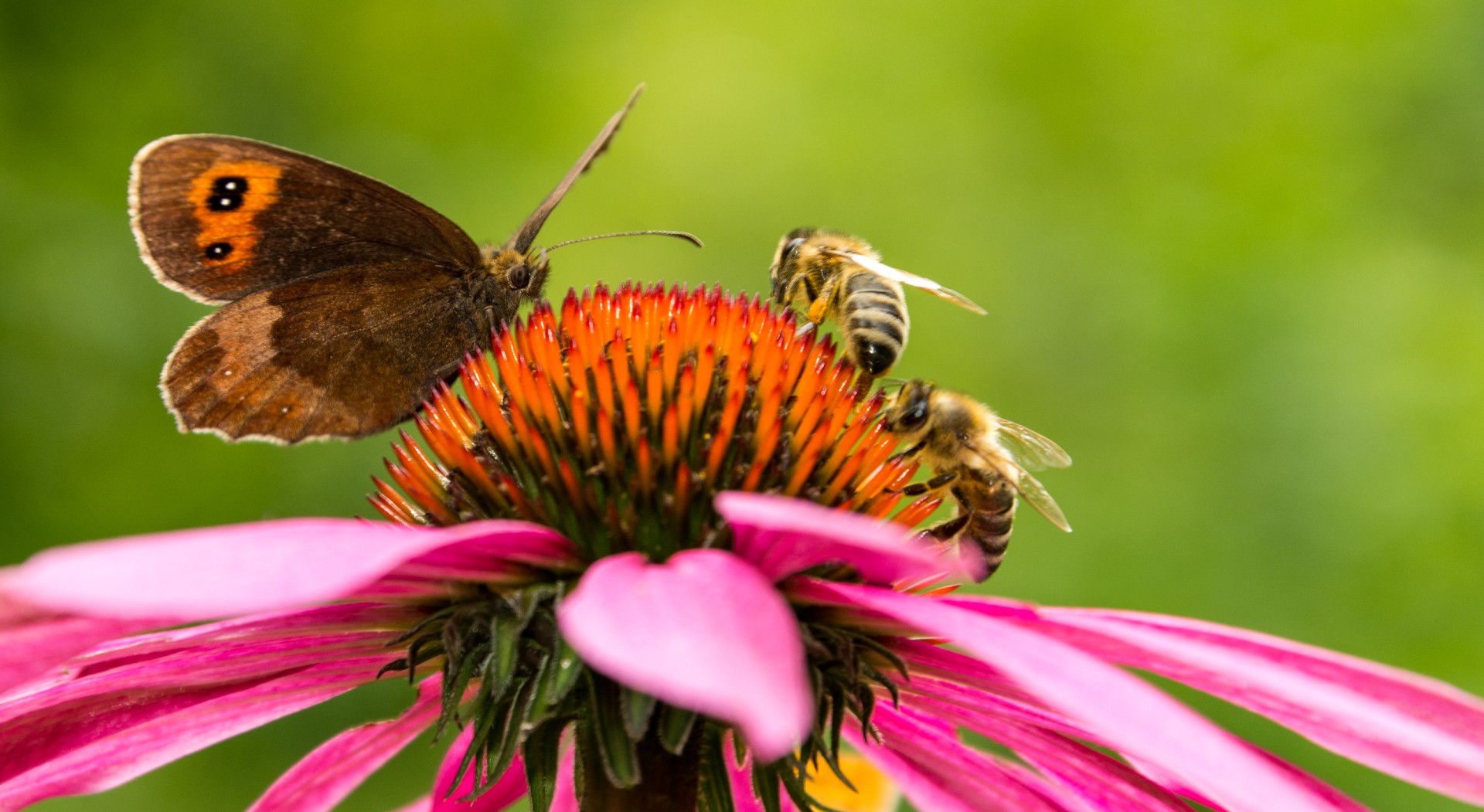Who: The Players in Pollination
Most people name bees and butterflies as pollinators, but the list is a bit more expansive and might surprise you.
Bees use nectar from flowers to provide the necessary fuel to fly. Protein and amino acids are essential to keeping young bees healthy. Bees forage frequently and visit a wide variety of food sources, so they are not picky foragers.
Butterflies are a bit pickier when it comes to foraging, and they prefer flowers that are round and have large petals. As you may have observed, the butterflies land on the large petals and use their proboscis (tongue) to poke the nectar center of the flower. Butterflies love sunflowers!
Hummingbirds are pollinators who are the most successful at drawing nectar from tube-shaped flowers. Hummingbirds have a long tongue that no other pollinator has in their toolbelt for foraging. Hummingbirds love honeysuckles!
Moths are underrated, although the ratio is more than ten moths to each butterfly in existence. Moths often forage at night, so they go unseen. They forage on blossoms that reflect the light of the moon and enjoy four o'clock and tobacco.
Beetles pollinate the soil and, although less elegant than bees and butterflies, are critical to keeping it fertile and nutrient filled. Beetles prefer forage sources close to the ground.
Flies are also pollinators and are most like bees in their foraging skills. They are attracted to things with a strong odor, whether good or bad. Flies may forage on sweet-smelling flowers or those that smell like animal feces.
Wind, wait, what? Yes, wind is considered a pollinator. Wind is responsible for pollinating grains, nuts, trees and grass which helps feed livestock. Most don't realize the significant role of wind in the pollination process!
What: The Game Plan
Pollination is essential to plant reproduction. The pollen that pollinators collect from a plant's anthers is carried to other plants and flowers. The pollen is passed onto the stigma of another plant, fertilizing the flower and ensuring its seeds and fruits year after year.
Fun Fact: Bees bite the anthers and shake it so the pollen comes off, and they can get it to stick to their hind legs.
Why: The Importance of Pollination
We learn from a young age the importance of pollination. Pollination allows our crops and food sources to thrive and balances the ecosystem, keeping it strong and healthy. Several foods we consume regularly rely on pollination, including apples, almonds, avocados, cherries, peaches, pears, blueberries, tomatoes, coffee, strawberries, lemons, grapes, and more!
When: Pollination Seasons
Although pollination is a year-round process, there are times and seasons when foraging is more competitive, and that is another reason diversifying plants and flowers is so tremendously valuable to pollinators. If pollinators have continual food sources, we are all better off.
In the spring, pollinators rely on blooming plants and flowers, which is when fruit trees are most visited. In summer and hotter months, gardens and plants are at their peak, and the longer days allow pollinators to forage for longer, collecting more nectar and pollen. In the fall, plants that bloom later allow pollinators to continue to forage in preparation for winter. Hummingbirds and Monarch butterflies hibernate and need to store enough resources to survive. Winter is a challenging time for pollinators. However, the best thing people can do is leave decaying plants because they may provide shelter for pollinators.
Summers can be harsh for pollinators, but they can regulate temperature by different behaviors. Bees flap wings in the hive to help keep it cool, so although summers can seem extremely hot, it is easier for bees in summer than in cold winter months. Being purposeful about planting a diverse garden that blooms at different times can help pollinators make it through all the seasons!

Get help with your beehive or bee swarm removal! Call Today 760-224-3040 Or 951-265-8292!
Helping Pollinators
Bee species are known to be on the decline. However, other pollinators are also experiencing reduced numbers based on environmental factors such as habitat loss, disease, parasites, and pesticide use. Individuals who want to make a positive difference for pollinators can create a pollinator-friendly space, and it is easy to do while keeping the aesthetic you want! Diversifying a landscape with a variety of plants and flowers, with attention to using native species, helps local pollinators and helps your region. Garden for Wildlife has lists of native plant species by zip code to help identify the best options for pollinators.
Visit your local beekeeper and purchase some local honey. Buying honey and other bee-made products supports local beekeepers and is known to have beneficial qualities for some allergies and other mild health concerns, like insomnia. If you need a bee removal company, use D-Tek. D-Tek is owned by a local beekeeper, has more than a decade of experience in beekeeping and live bee removals, and is committed to helping link people to pollinator health and its importance.
Call today 760-224-3040 or 951-265-8292!
